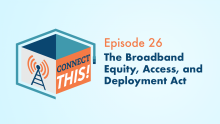What States, Communities, and Activists Need to Do to Make the Most of the Infrastructure Act - Episode 484 of the Community Broadband Bits Podcast

On this week’s episode of the Community Broadband Bits Podcast, Christopher Mitchell brings back a longtime favorite guest, Jon Chambers, Partner at Conexon, to talk about what is next for municipal and cooperative broadband efforts given the Infrastructure Investment and Jobs Act.
The two discuss the importance of rural cooperatives when connecting some of the most underserved areas of country. Chamber said the number of dollars isn’t what’s impacting the increased connectivity around the country. The impact depends on where those dollars are going, and this infrastructure legislation will hopefully create a more direct line to cooperatives, given the fact it will be dispersed through block grants to the states.
They talk about new issues that could arise given the FCC’s new polygon mapping method and how it will almost certainly slow down disbursement of funds.
Finally, they hone in on what communities can do to help channel these dollars in the right direction and bring high-speed, reliable Internet to folks across the country.
This show is 49 minutes long and can be played on this page or via Apple Podcasts or the tool of your choice using this feed.
Transcript below.
We want your feedback and suggestions for the show-please e-mail us or leave a comment below.
Listen to other episodes here or view all episodes in our index. See other podcasts from the Institute for Local Self-Reliance here.
Thanks to Arne Huseby for the music. The song is Warm Duck Shuffle and is licensed under a Creative Commons Attribution (3.0) license.



